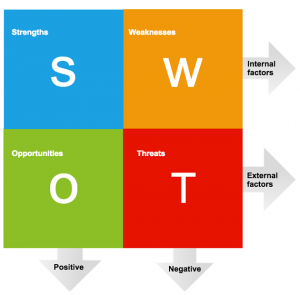Every now and then, you will have to conduct a Strengths, Weaknesses, Opportunities and Threats analysis on your business, branded offerings or even for your client. Aside that, knowing what to lookout for makes your work far easier during that job assessment that requires case analysis.
No doubt you must have been told that Strengths and Weaknesses are visible within the internal dynamics while Opportunities and Threats conceal themselves in external uncontrollable factors.

I also imagine you are aware, every single internal and environmental component can either be favourable or unfavourable to the concerned entity.
Taking the factor of Reputation for instance, a brand can have favourable or bad reputation in the market. Reputation, an internal element, can be either strength (reputable) or a weakness (perceived bad reputation).
Beyond that basic knowledge, having a checklist of reference will set you up and running in performing a thorough assessment. But before we delve into the checklist, let’s define each of the SWOT components for avoidance of doubt.
While Strength is any identifiable internal dynamic wherein the entity performs above average especially in relation to competition, Weakness is the opposite. Weakness is where that brand performs below average.
In the same vein and within the macro-environment, a marketing Opportunity is an area of buyer need or potential interest where the concerned brand can perform profitably. In the absence of a defensive Marketing action, a Threat is any development outside the organization that can result in deterioration of sales or profitability.


STRENTHS and WEAKNESSES Checklist:
• Leadership capability
• Employee dedication
• Organizational orientation
• Procedural tendency (responsive, reactive, bureaucratic, etc)
• Economies of scale
• Production capacity
• State of Facilities, equipment or machinery
• Corporate or Brand reputation
• Coverage
• Finance stability or lack thereof
• Product or service quality
• Distribution effectiveness
• Availability of Technical skills
• Innovation effectiveness
• Promotion effectiveness
• Internal marketing outlook
• Market Share
OPPORTUNITIES AND THREATS
• National or international policies
• Logistics
• Cost changes
• Capital accessibility
• Cost of capital
• Specific industry risks
• Market profitability
• Cash flow

• Regulatory changes
• Distribution Channel conflicts
• Emerging trends and tastes
• Industrial requirements
• Social trends and activists movements
• Economic changes like inflation, exchange rates, monetary policies, etc
• Changes in supply chain
• Market Growth Rate
• Environmental concerns and changes
• Competitive intensity and changes
• Technological advances and disruptions
• Total Market Value or size
• Demand
• Political instability, racial war, terrorism, etc
• Religious Inclination
• Market Share
Also, Score and Canon have provided us the following questions for the same purpose.
Asking and answering these questions will help you decipher positives and negatives. You will also notice the link between the list of questions below and the checklist above.
1. What is my company’s competitive advantage?
2. What is our unique selling proposition?
3. Do we have exclusive relationships with suppliers or distributors?
4. How extensive is our distribution network? What are the strengths of our marketing and sales team?
5. Do we have a well-known brand?
6. What complaints do we frequently hear from customers?
7. What objections do we frequently hear from prospects?
8. Is the business’s distribution limited?
9. Does the business’s location or physical plant have any weaknesses?
10. Are the business’s technology, equipment and machinery outdated?
11. Is the business adequately staffed?
12. Do employees lack skills or expertise needed to compete?
13. Does the business suffer from cash flow problems?
14. Are the business’s profit margins and other financial indicators poor compared to those of competitors?
15. Does the business have excessive debt?
16. Would the business have difficulty accessing additional capital?
17. Do competitors have any weaknesses the business could benefit from?
18. Is the target market changing in ways that could benefit the business?

19. Is there a potential niche market the business is currently ignoring?
20. Is there something clients and customers are asking for that the business doesn’t provide, but could add?
21. How might current and projected economic trends present opportunities for the business? (i.e., housing prices, employment rates, consumer confidence)
22. What changes are taking place in the industry that could create opportunity?
23. Are there potential new sources of financing that could help the business?
24. Could projected changes in interest rates, tax laws or banking regulations benefit the business?
25. Are there upcoming local, regional or national events that could present opportunities for the business?
26. What opportunities for geographic expansion exist?
27. How might proposed changes to local, state and national government positively affect the business?
28. How might predicted technological advances negatively affect the business?
29. Could local, state and national governmental changes, such as regulatory restrictions or new trade agreements, negatively affect the business?
30. Are there projected increases to the cost of doing business (i.e., rent, wages, inventory, utilities) that could hurt the business?
31. Could changes to external financial factors, such as revised lending standards, increased cost of capital or higher interest rates, hurt the business?
32. What predicted industry trends could hurt the business?
33. How might current and projected economic trends (i.e., housing prices, employment rates, consumer confidence) negatively impact the business?
34. Are there businesses that aren’t currently direct competitors, but could be in the future?
35. Are our competitors planning expansion, new product or service launches, or other changes that could hurt our business?
36. Does the business rely too heavily on one big customer?
37. Could predicted social changes negatively impact demand for our product
38. Is our target market shrinking?
39. Are there potential new sources of financing that could help the business
40. How could predicted technological advances create opportunity for the business?
41. Could projected changes in interest rates, tax laws or banking regulations benefit the business?
42. What is my company’s competitive advantage?
43. Do we have exclusive relationships with suppliers or distributors?
44. How extensive is our distribution network?
45. What is our unique selling proposition?
46. Do our employees have skills or expertise that our competitors’ employees lack?
47. Do our employees have professional accreditations or certifications that give us an advantage?
48. Do we have proprietary technology, intellectual property or other valuable proprietary information?
49. Do we have equipment or machinery that our competitors don’t?
50. Does our location or building give us a competitive advantage?
51. How well capitalized is the business?
52. Can we easily access additional capital if needed?
53. Do the business’s profit margins and other financial indicators compare favorably to industry benchmarks?
You may have noticed almost all departmental functioned have been audited in the above questions. That is how it ought to be. Every function possesses Internal or external dimensions that can aid or hurt the business.
Also, I may have omitted few others you are aware of, please, add on the comment section
Don’t forget to share your thought with the author on kalukelechi.o@gmail.com